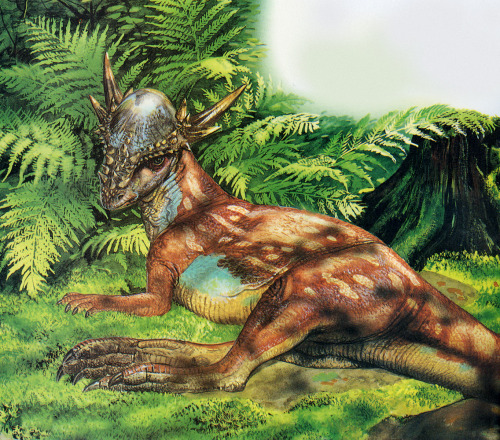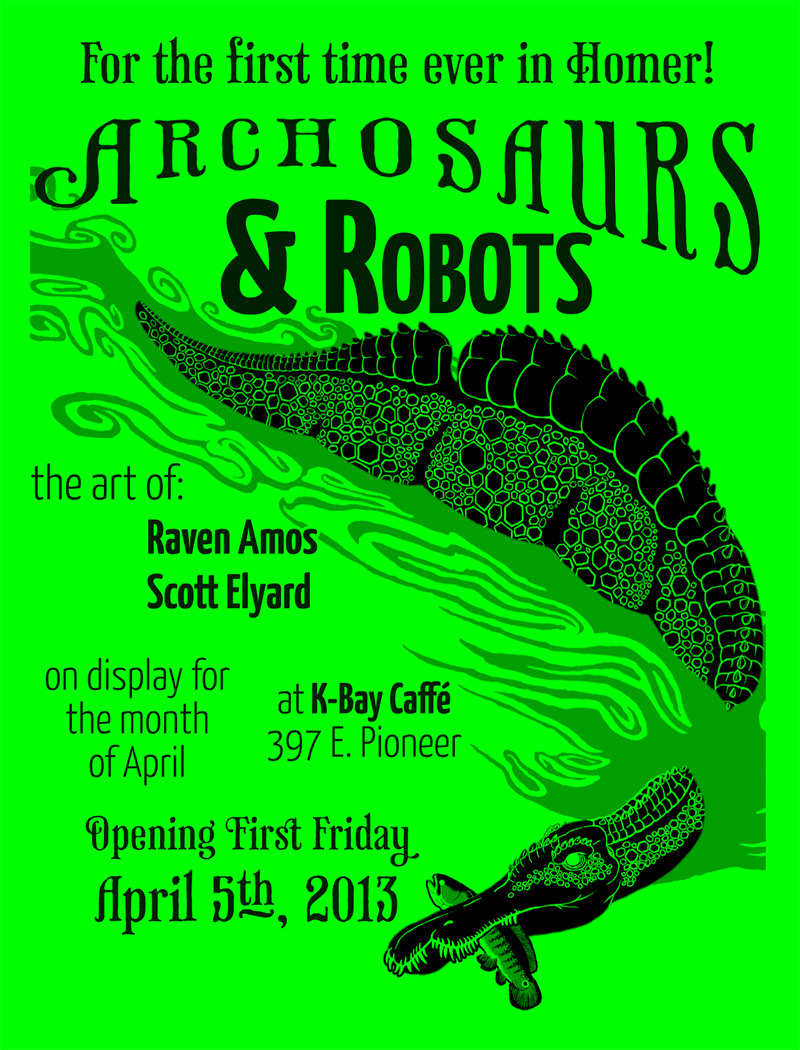Tonight is First Friday, and that means "Archosaurs & Robots" is a go! This show will feature previous works from Scott Elyard and I's previous exhibitions - "Dinosaurs & Robots" and "Archosaurs & Automata" - as well as a couple of new pieces.
If you are in Homer, AK during the month of April, come check out the show at K-Bay Caffe on Pioneer Avenue, next to The Grog Shop. Opening reception will be tonight at 6 p.m.
----
In other somewhat related news, a version of "Swamp Dragon" is now available through the Neatorama blog's "Neatoshop" as a high-quality t-shirt. Stay tuned for new designs!
Friday, April 5, 2013
Sunday, March 17, 2013
Were Dinosaurs "Lounge Lizards"?
 |
| Painting by Steve Kirk. |
I am skeptical of this -"lounging," as is depicted here, is something that I've found in my studies (admittedly limited in comparison to some of my readers) to be a distinctly mammalian trait. Crocodiles, birds, and squamates do not, in my experience, exhibit this kind of resting behavior where they lay upon their sides, with the majority of their weight upon their ribcage, hip, and tucked-under leg.
Birds have a variety of sleeping postures and habits ranging from snoozing standing up (sometimes on one leg!), to nesting with both legs folded up under the body, to perching - or, in the case of some hummingbird species, hanging upside-down like little, feathery bats. Their heads are either tucked behind the wing, or pulled into their bodies with their beaks resting on their chests.
 |
| ...or like this. (Photo by Rinaldo Santos de Almeida) |
 |
| Photo removed at the request of the image distributor. |
Thursday, March 14, 2013
Lesser Bowertyrants - All Yesterdays Contest Entry
I know, it's been awhile and I still haven't posted something on my blog here about the art show in January. I did want to do a quick update and post my second entry for Irregular Books' "All Yesterdays" art contest (entry #1 being my "Swamp Dragon" icthyovenator painting).
X-posted from my DeviantArt page:
X-posted from my DeviantArt page:
I title this piece "Lesser Bowertyrants" - it depicts a courting pair of Gorgosaurus, with the male displaying his mating colors and feathers, offering his potential mate a Lambeosaurus skull trophy. The bower is an "avenue" type bower, with carefully arranged driftwood logs and scavenged bones on either side of a narrow aisle festooned with stones, bits of wood, and chunks of vertebrae - anything that is white or light in color. Other bowertyrants, such as the "Greater Bowertyrant", or Tyrannosaurus rex, create their bowers from strategically gnawed trees, adorned with the decapitated heads of triceratops or other prey animals. All species are able to cannibalize the more edible parts of their bowers in times of drought or famine, deriving an extra shot of calcium from the bones therein. Indeed, it is the very reason the male offers the choicest bits to his would-be mate - the extra calcium in the offered bones allows for better egg production and a healthier brood.
 |
| "Game of Bones" |
I had originally planned on adding additional sketches of other species of bowertyrant, including T. rex (greater bowertyrant), Albertosaurus, and the more distantly related Tarbosaurus, but time got away from me. As you can see from the sketch on the left, the greater bowertyrant's "love palace" is quite different, and more grim, than it's smaller cousin's, inspired in part by the Nature article on how T. rex may have butchered his Triceratops prey.
In other news, Scott Elyard and I will be putting on an art show in Homer, AK next month. More on that soon.
Monday, January 14, 2013
All Yesterdays Contest Entry - "Bowertyrants"
#AllYesterdays and #10oclockart entry - "Bowertyrants"
Something to fill the gap while I draft something up for a synopsis of our show opening in Anchorage this month.
I give you Gorgosaurus libratus - or as I am calling here, the "lesser bowertyrant" - in wild turkey livery, puffing up for an as-yet-painted female, showing off some choice items from the collection of bones, stones, and driftwood that make up his bower.
I will include other notes and sketches detailing the gregarious behavior of young males, banding together to bring down large game to add to their collections, and how as they age, they become more solitary and confrontational, choosing to stick around their home territories. Thievery and vandalism is rampant among neighboring mature males, and such acts often lead to violence, injury, or even death if the neighbor happens to be caught in the act. The strongest and most ferocious may even display the skulls of their bested rivals - a surefire way to impress a potential mate.
Something to fill the gap while I draft something up for a synopsis of our show opening in Anchorage this month.
I give you Gorgosaurus libratus - or as I am calling here, the "lesser bowertyrant" - in wild turkey livery, puffing up for an as-yet-painted female, showing off some choice items from the collection of bones, stones, and driftwood that make up his bower.
I will include other notes and sketches detailing the gregarious behavior of young males, banding together to bring down large game to add to their collections, and how as they age, they become more solitary and confrontational, choosing to stick around their home territories. Thievery and vandalism is rampant among neighboring mature males, and such acts often lead to violence, injury, or even death if the neighbor happens to be caught in the act. The strongest and most ferocious may even display the skulls of their bested rivals - a surefire way to impress a potential mate.
Wednesday, December 12, 2012
Ichthyovenator laosensis - "Swamp Dragon"
#10oclockart - Finished my ichthyovenator painting for the #ArchosaursandAutomata art show in record time!
Ichthyovenator laosensis - the fish-eating hunter of Laos, known only from a single type specimen found in the Aptian age Grès supérieurs Formation. Siamamia, a Cretaceous cousin of the North American bowfin fish, is known from similarly aged rocks in the Sakon Nakhon Province of Northeastern Thailand.
Cavin, L., V. Suteethorn, E. Buffetaut, J. Claude, G. Cuny, J. Le Loeuff, and H. Tong (2007), "The first sinamiid fish (Holostei, Halecomorpha) from Southeast Asia (Early Cretaceous of Thailand)", Journal Of Vertebrate Paleontology, v. 27(4), pp. 827-837.
Switek, Brian. "Ichthyovenator: The Sail-Backed Fish Hunter of Laos." Dinosaur Tracking - Smithsonian Magazine Blogs (2012), n. page. Web.
"Ichthyovenator." Prehistoric Wildlife. (http://www.prehistoric-wildlife.com/species/i/ichthyovenator.html), n.d. Web. 02 December 2012.
 |
| Swamp Dragon © 2012 Raven Amos |
---
References:
Switek, Brian. "Ichthyovenator: The Sail-Backed Fish Hunter of Laos." Dinosaur Tracking - Smithsonian Magazine Blogs (2012), n. page. Web.
"Ichthyovenator." Prehistoric Wildlife. (http://www.prehistoric-wildlife.com/species/i/ichthyovenator.html), n.d. Web. 02 December 2012.
Monday, December 10, 2012
Siamamia Has A Bad Day
#10colockart (the "it's 10 somewhere" edition) - Closeup of facial details of Ichthyovenator and the work done on the Siamamia in its jaws.
Thursday, December 6, 2012
Dino Zodiac/Archosaurs & Automata
#10oclockart Ichthyovenator/Pisces. I just might be able to finish this in time for the show!
A somewhat fanciful (see, Zach? I called it "fanciful"!) representation of the spinosauroid from Laos, known only from a pelvic girdle and a few bits of vertebrae. The fossil shows a strange, dual-hump configuration, with flat, paddle-like neural spines that abruptly reduce in size at the joining of the hips with the trunk of the body.
Sunday, December 2, 2012
Conchoraptor gracilis - "Nemegt Sunrise"
#10oclockart PM edition - It's FINALLY finished! Sorta.
 |
| Nemegt Sunrise © 2012 Raven Amos |
The crab in its claws is purely speculative, given there is no fossil evidence of hermit crabs found in the Nemegt Formation. The shell that it inhabits, a species of Viviparus, is known from the neighboring Dohoin Usu fossil beds to the north, which are of a similar age to the Nemegt formation (Late Cretaceous).
Special thanks to Jamie Headden for the pointers on oviraptor anatomy, and to Scott Elyard for helping to keep me sane.
---
References:
Ping, Chi; Granger, Walter. (1930). "Two new Cretaceous fresh-water gastropods from Mongolia". American Museum Novitates; No. 437.
Wednesday, November 28, 2012
Nemegt Sunrise
P.M. entry for #10oclockart - sunrise over the Nemegt River Delta of Cretaceous Mongolia.
Flora from the Maastrichtian era Nemegt Formation is spotty at best, but existing fossil evidence shows that there was some form of forest cover in the form of Pseudolarix conifers, with some hypothetical Baikalophyllum cycads and reedy plants thrown in the mix (known from similar localities in China and Russia).
----
Flora from the Maastrichtian era Nemegt Formation is spotty at best, but existing fossil evidence shows that there was some form of forest cover in the form of Pseudolarix conifers, with some hypothetical Baikalophyllum cycads and reedy plants thrown in the mix (known from similar localities in China and Russia).
----
References:
Pott, C., McLoughlin, S., Lindström, A., Wu Shunqing, & Friis, E.M., 2012. "Baikalophyllum lobatum and Rehezamites anisolobus: two seed plants with “cycadophyte” foliage from the Early Cretaceous of eastern Asia." International Journal of Plant Sciences 173, 192–208.
Gradzinski, Ryszard. 1969. "SEDIMENTATION OF DINOSAUR-BEARING UPPER CRETACEOUS DEPOSITS OF THE NEMEGT BASIN, GOBI DESERT." Palaeontologia Polonica, No. 21, 148-223.
Okada, H. Cretaceous Environments of Asia (Developments in Palaeontology and Stratigraphy). Mateer, N.J. Elsevier Science, April 2000.
Monday, November 19, 2012
Archosaurs and Automata Update
Progress report on the #ArchosaursandAutomata art show.
 |
| Conchoraptor progress... |
The Indiegogo campaign for the upcoming "Archosaurs and Automata"art show is over, and while we only made 60% of our goal, Scott and I are still looking forward to putting up one awesome art show this January!
After talking with Jaime Headden of "The Bite Stuff" blog and showing him my progress so far on the Conchoraptor, I received some very helpful advice and pointers on the anatomy of this very strange theropod. I've also begun work on the poor, helpless creature in her claws - a hypothetical freshwater hermit crab that has taken up residence in the shell of an ammonite (like this guy).
After talking with Jaime Headden of "The Bite Stuff" blog and showing him my progress so far on the Conchoraptor, I received some very helpful advice and pointers on the anatomy of this very strange theropod. I've also begun work on the poor, helpless creature in her claws - a hypothetical freshwater hermit crab that has taken up residence in the shell of an ammonite (like this guy).
Subscribe to:
Posts (Atom)






